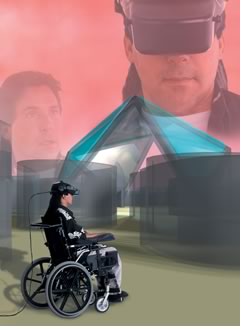
Limited mobility does not hinder design ability

Associate Editor
Immersive technology is the way of the future in architecture design, says Darric McCormick, a recent graduate of the College of Architecture and Environmental Design at California Polytechnic State University, San Luis Obispo. McCormick is in a unique position to make this claim. Unlike many of his college classmates, he spent most of his education working in the medium and helping to develop tools that make immersive technology and virtual reality programs more responsive to the needs of architects. He also worked with computer science students at the university to develop voice recognition software to expand the capabilities of the program even further.
 His
interest in immersive technology is beyond academic; it is also physical
and emotional. A diving accident in 1988 left McCormick, a general contractor,
paralyzed from the neck down. At the time, he was given 72 hours to live.
During the ensuing days, months, and years he and his wife, Susan, devoted
their energies to McCormick's recuperation. He has defied the odds at
each point along the way.
His
interest in immersive technology is beyond academic; it is also physical
and emotional. A diving accident in 1988 left McCormick, a general contractor,
paralyzed from the neck down. At the time, he was given 72 hours to live.
During the ensuing days, months, and years he and his wife, Susan, devoted
their energies to McCormick's recuperation. He has defied the odds at
each point along the way.
After proceeding past the 72 hour mark, he was told he would be ventilator dependent for the rest of his life. McCormick disregarded this prediction, and six weeks later he transferred to a different hospital for rehabilitation. Daily phone calls from his father, who has since passed away, and visits from his wife helped him through the difficult period. On the first day of his release from the hospital, Susan gave birth to their daughter, Heather.
A good foundation
Away from the hospital, McCormick contemplated how he would support his
family. He said his work as a general contractor provided him with a good
foundation for studying architecture. He had always liked working with
architectural concepts as a builder, and soon decided he could "create
things mentally," if not physically. He committed to getting his
GED, and then to taking courses at Moorpark College that would help him
gain admission to Cal Poly.
He said one of the hardest things was letting go of knowing the practicality of design from his work as a contractor—and letting loose. He said he worked to make his designs more fluid, rather than construction documents.
According to information published by Cal Poly, four years later, in 1995, McCormick was using AutoCAD design software by learning to wear a HeadMaster, "adaptive hardware that allowed him to fully utilize a computer mouse using head turns and a tube that he could blow into." He earned his associate of arts degree from Moorpark, with a focus on math and physics. Armed with a high grade point average and degree of confidence, he was soon accepted into Cal Poly's architecture program.
 Once
he began his studies at Cal Poly, McCormick continued to immerse himself
in three dimensional modeling, and started his "learning by doing"
studies, taking computer design classes in rendering, animation, and modeling.
Throughout his college career he sought to reach across architecture and
academic disciplines to create a "web of design minds" and to
"network campus disciplines together" to make technology more
relevant to architecture studies and to campus life in general.
Once
he began his studies at Cal Poly, McCormick continued to immerse himself
in three dimensional modeling, and started his "learning by doing"
studies, taking computer design classes in rendering, animation, and modeling.
Throughout his college career he sought to reach across architecture and
academic disciplines to create a "web of design minds" and to
"network campus disciplines together" to make technology more
relevant to architecture studies and to campus life in general.
In 1999, he began to work with two professors and a virtual reality mechanism to elevate his skills to the cutting edge of technology. Computer science professor Lewis Hitchner and architecture professor Thomas Fowler IV, Assoc. AIA, invited McCormick to participate in the development of an innovative project that was to become known as "immersive visualization." McCormick recalled, "This was the first time I was able to have the feeling that I was immersed inside of a project that I designed. The head mounted virtual reality goggles had such a wonderful impact on me that I started to cry as I moved." Now a grant from Pacific Bell will help continue to develop the ImmersaDesk project at Cal Poly.
Larger impact
This has larger impact for students and the architecture profession, Fowler
and McCormick agreed.
"The work that Darric generates with these tools is quite amazing-the textures, the use of light to help him design," Fowler said. This technology helps students train as architects. People can "immerse themselves in design and create full-scale mock-ups." He also said they can also immediately understand their mistakes.
The technology is also "beneficial to students who do not have a disability," and is especially good to use early on in the design process," Fowler said. "It helps answer the questions, 'What have I done? What does it feel like? What does it look like?'" Fowler also believes the computer generated images exceed the level architects can publish on paper.
McCormick agrees, and after nine years of schooling he seeks to find a firm that that employs cutting-edge technology to deliver superb customer service to its clients. He is now in the process of interviewing.
His theory: "Don't restrict yourself to the capabilities of the software. Decide 'what do I need to get done and then challenge the software'" to do it.
McCormick is certainly no stranger to challenges, and said he is eager to get into to workforce and produce designs. No doubt his wife Susan will be at his side as she has been throughout his 13 year journey. Upon graduation she was presented with the program's first-ever Certificate of Achievement. She received it during commencement ceremonies for her years of dedication and teamwork with her husband while he earned his BArch degree. He calls her his "right hand person."
"A few hundred dollars for adaptive equipment," he said, "and I'm on my way to performing equal to, or better than, most able-bodied employees."
His professor, Fowler, agrees. "Darric would do computer models that are amazing to me . . . faster than students can do by hand."
Copyright 2001 The American Institute of Architects. All rights reserved.
![]()
|
To contact Darric McCormick, send email to spire@thegrid.net. Photos: Cal Poly San Luis Obispo architecture graduate Darric McCormick uses virtual reality goggles that allow him to view his designs before they are built. McCormick and his wife Susan at the Cal Poly San Luis Obispo commencement ceremonies on June 16. Susan received the first-ever Certificate of Achievement from College of Architecture and Environmental Design for her years of dedication and teamwork with her husband Darric while he earned his Bachelor of Architecture degree. |
|